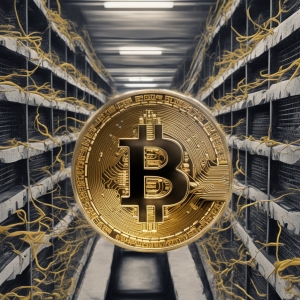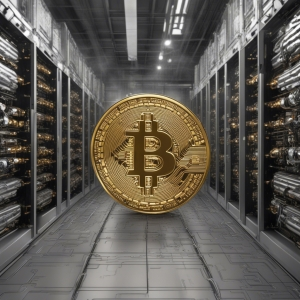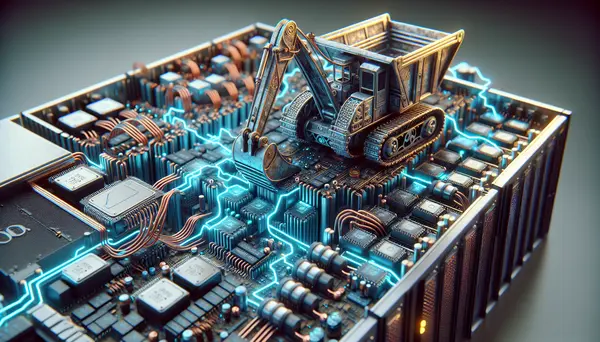Table of Contents:
Introduction to Bitcoin Mining
Bitcoin mining is the process through which new bitcoins enter circulation. It's also a critical component of the maintenance and development of the blockchain ledger. By using high-speed computers and newer technology, miners solve complex math puzzles, ensuing in adding a new block to the blockchain. In return, they receive a reward in the form of new bitcoins.
At first glance, bitcoin mining may seem like an easy way to earn a passive income. However, beyond the enticing prospect of earning bitcoins lies a range of hidden costs that potential miners might overlook. Substantial operating expenses such as electricity costs, equipment cooling, machine maintenance, and many more add up quickly, gobbling into the profitability. In the succeeding sections, we will delve deeper into these hidden costs of bitcoin mining, providing you with a more comprehensive understanding of the landscape before you take a dive.
Get $500 free Bitcoin mining for a free testing phase:
- Real daily rewards
- 1 full month of testing
- No strings attached
If you choose to buy after testing, you can keep your mining rewards and receive up to 20% bonus on top.
Understanding the Hidden Costs of Bitcoin Mining
Many people perceive bitcoin mining as only the investment in fast and powerful hardware. However, there's much more to it than just setting up a mining rig. Potential miners must consider various hidden costs that make a significant dent in the mining profits that are often overlooked in the initial calculation. These are costs related to power consumption, infrastructure, maintenance, and unexpected fluctuations that can affect profitability. Understanding these costs is essential in helping you determine whether starting up a mining operation is a financially viable decision for you. Let's look into these hidden aspects of bitcoin mining in further detail.
Analysis of Overlooked Expenses in Bitcoin Mining
| Pro | Contra |
|---|---|
| Potential for high return on investment | High electricity consumption |
| Opportunity to support decentralized currency | Potential for severe hardware wear and tear |
| Possibility to "earn" cryptocurrency instead of buying | Hidden costs such as cooling equipment and enhanced internet connection |
| Increased computing power could have secondary applications | Environmental impact of high energy consumption |
| Blockchain intelligence that could result in technological advancements | Dependence on Bitcoin value, it could plummet any time |
Determining The Direct Costs

One of the primary expenses tied to bitcoin mining is the cost of the hardware. Mining rigs are specialized computers that must have enough processing power to solve complex mathematical problems. Over time, these problems become more difficult, meaning the miner must continue to upgrade their equipment to solve them. You might think of this only as your starting investment, but the truth is that hardware costs are a frequent expense that can drastically impact your profitability.
Another significant direct expense associated with Bitcoin mining is the cost of electricity. The Hardware used for Bitcoin mining consumes a considerable amount of electricity. Depending on where you live, the cost to power your mining equipment can eat into your profits dramatically. In regions where electricity costs are particularly high, the expense might negate any profit you might have hoped to make.
Many times overlooked is the cost of the Internet. The mining process requires a stable, high-speed internet connection to function optimally. This internet connection is a cost that will continue throughout the life of your mining operation.
These three are the most recognizable and substantial direct costs associated with Bitcoin mining. However, they're not the only costs that you might encounter when mining. There are several indirect or hidden costs that can seriously impact your bottom line.
Unveiling The Indirect Costs
Now that you are aware of the direct expenses of Bitcoin mining, let’s uncover some of the hidden or indirect costs associated with this undertaking. One major indirect cost comes in the form of the cooling requirement. Yes, you read it right, cooling. Bitcoin mining generates a significant amount of heat, making the cost of cooling the mining equipment a considerable expense.
Miners often ignore this aspect of Bitcoin mining. However, without proper cooling, the efficiency of your equipment can drastically reduce over time leading to hardware failure, increasing your maintenance or replacement costs. Therefore, a well-designed cooling system is necessary to keep your mining apparatus in optimal working condition, in turn, increasing its durability.
Furthermore, other hidden costs surface from the infrastructure required for the mining operation. For instance, you might need an upgrade in your electricity setup to meet the high power demands of the mining rig. You might have to factor in for the space requirement as well, to house your mining hardware. The need for advanced security systems to protect your digital assets also contributes to overall indirect costs.
Lastly, what remains unseen is the value change. Bitcoin, like any investment, can fluctuate in value. If the price of Bitcoin experiences a serious downturn, the profitability of mining can dip significantly, potentially making it unprofitable. Essentially, this risk of loss is another hidden cost you should factor into your calculation.
Conclusion: The Hard Truth About Bitcoin Mining Costs

Bitcoin mining is often seen as a golden path to riches due to its potential rewards. However, it is important to understand that mining requires substantial initial start-up and operational costs, including several hidden ones such as cooling and security. Additionally, the dynamic nature of Bitcoin's value adds an element of financial risk to the investment. Therefore, any decision to engage in Bitcoin mining should be based on a detailed cost-benefit analysis inclusive of all the direct and hidden costs. Remember, the key to financial success in Bitcoin mining lies in careful planning and understanding these costs.
The Environmental Costs: An Overlooked Aspect
Another overlooked cost of Bitcoin mining is the environmental toll it takes. The process uses massive amounts of electricity, contributing significantly to carbon emissions. While these costs aren't financial per se, they should be considered before venturing into mining, as the environmental effects are a shared burden for us all.
Mining facilities tend to congregate in regions offering cheap electricity, often derived from environmentally detrimental sources, like coal. The result is a substantial environmental footprint that continues to expand with the growth of the Bitcoin network.
Furthermore, the hardware itself has a lifespan and once obsolete, contributes to electronic waste unless properly recycled. The sheer scale of mining operations and the rapidity with which hardware becomes outdated signifies a significant environmental carried hidden cost.
The global shift towards sustainable practices and green energy inevitably prompts us to take these ecological factors into account. These costs are often left out of financial equations, but as the effects of climate change escalate, they become ever more pressing for potential miners and society as a whole.
Mitigating the Hidden Costs of Bitcoin Mining

Now that we are familiar with the hidden costs of Bitcoin mining, let's focus on the ways to mitigate these expenses. While it's nearly impossible to sidestep these costs entirely, you can employ various strategies to reduce and manage them effectively.
Firstly, selecting energy-efficient equipment is indispensable. Energy-efficient hardware not only reduces your electricity consumption but also generates less heat, addressing the cooling cost at the same time. Be thorough while choosing your mining hardware, compare energy efficiencies before taking the plunge.
Maintain your mining equipment properly to lengthen its lifespan and reduce the frequency of costly replacements. Keeping it dust-free, providing adequate cooling and managing the workload can enhance your equipment’s longevity.
Choosing the right location for your Bitcoin mining operation can significantly affect the profitability. Select regions where electricity costs are low, and internet connectivity is reliable. Furthermore, colder regions may help to reduce the costs associated with cooling the mining hardware.
Lastly, to cope with the price fluctuations, diversifying your crypto investments can be a smart move. This diversification can provide you with a safety net during times when Bitcoin value fluctuates.
Understanding and mitigating these hidden costs equips potential Bitcoin miners with the information needed to make an educated financial decision. Remember, while Bitcoin mining has potential for profit, it's not without its costs.
Conclusion: The True Cost of Bitcoin Mining
Mining Bitcoin appears to be a profitable venture on the surface. It's indeed possible to make substantial gains, given the right set of circumstances. However, it's pivotal to acknowledge and understand the less visible, but significant, costs associated with it.
From the considerable power consumption to the need for cooling the machinery, the expense of internet connectivity, the costs for providing a secure environment to house your operations, as well as the constant need for hardware upgrades, these costs can quickly mount up and impact the overall profitability of your mining operations.
Moreover, the high volatility of Bitcoin's value can turn tables quickly, impacting your mining profits. Consequently, performing due diligence and carefully assessing risk is critical before diving into the world of Bitcoin mining. Also, it's advisable to keep checking the potential profit margins depending on the current market trends of Bitcoin.
In conclusion, Bitcoin mining is more than purchasing a mining rig and waiting for the coins to start dropping. It involves carefully calculated strategies, vigilant monitoring of costs, and a keen understanding of the cryptocurrency market. These preparation fundamentals defy the illusion of easy riches through Bitcoin mining and unravel the true hidden cost of this enterprise.
The Unseen Aspects of Bitcoin Mining
What are the hidden costs of Bitcoin Mining?
The hidden costs refer to the high electricity consumption, cooling equipment costs, and frequently changing technology requiring system upgrades.
How much electricity does Bitcoin Mining consume?
Bitcoin Mining's electricity consumption can vary greatly depending on the efficiency of the mining rig, but it's known to be energy-intensive, comparable to that of some small countries.
Do I need cooling equipment for Bitcoin Mining?
Yes, without appropriate cooling, mining rigs can overheat, which can cause hardware damage and decrease operational efficiency.
How often do I need to upgrade my equipment for Bitcoin mining?
The pace at which you need to upgrade depends on the rig but with increasing mining difficulty and technology advancement, some miners may need to upgrade their equipment every couple of years.
Is there a way to reduce the cost of Bitcoin mining?
Miners can reduce costs by using energy-efficient equipment, selecting locations with lower electricity rates, or using renewable energy sources.






